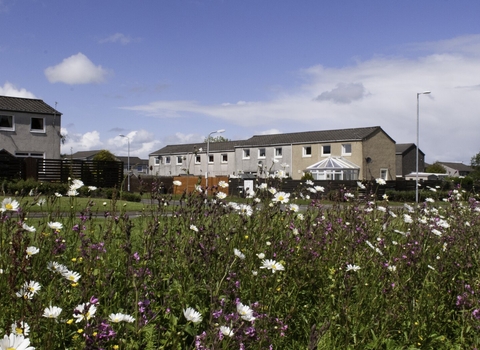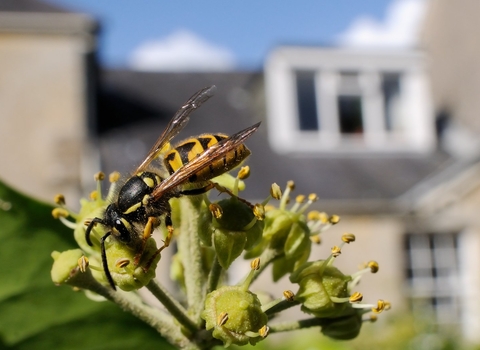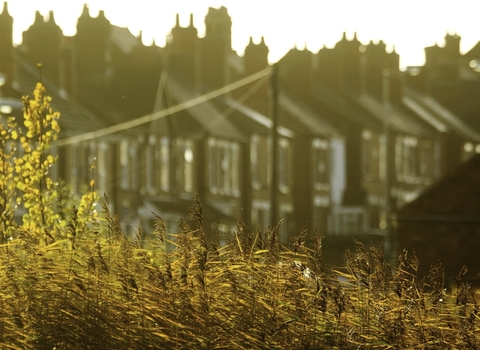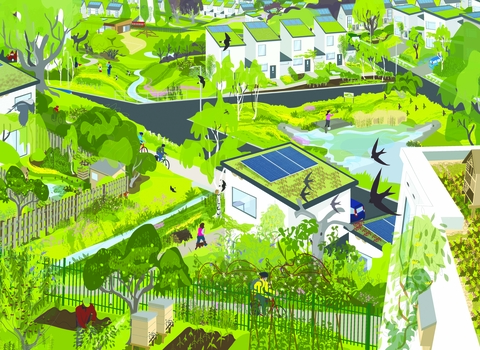Planning for development and nature
The Government’s ambition is 300,000 homes a year to be built by the mid-2020s
It has also made a commitment to be the first generation to leave our environment in a better state than we found it. Some might argue that these are conflicting objectives and at a time when nature is in deep trouble and when we are losing habitats at an unprecedented scale.
Much of this loss has been due to external pressures and government policies driving intensive agriculture, but built and unsustainable development continues to be a major contributor.
As farmland has become less hospitable to wildlife, so the importance of our urban natural areas has increased. Yet, in towns and cities, many gardens and small incidental natural spaces continue to be converted into buildings and hard standing - leading to a creeping, but large-scale reduction in the naturalness of many urban landscapes.
More and more people live their lives with little or no contact with nature and developments often miss opportunities to make neighbourhoods more natural and healthier, and instead damage what is already there. Continuing development in this way, and on an increasingly bigger scale, is not sustainable for wildlife, wild places, the character of neighbourhoods and the people who live there.
Linked also to development is the increase in the level of phosphates entering our water courses. If you would like to learn more about how phosphates affect Somerset, please visit the link below. For information about water quality in general, please click here.
The impact of development on biodiversity

Wildflower verge - Katrina Martin / 2020VISION
Development can have a significant negative on biodiversity:
- Direct loss of wildlife habitats
- Fragmentation and isolation of wildlife habitats
- Changing natural processes, such as the local water regime or sediment flow
- Changing the availability and/or quality of natural resources, such as water, clean air, light
- Damage/destruction of populations of wild plants or animals
- Indirect damage, such as recreational pressure and domestic animal predation on habitats
- Reducing options for responses to future environmental change/enhancements
- Broader environmental impacts, eg. increased carbon dioxide emissions

Common wasp (Vespula vulgaris) worker feeding on Ivy flower (Hedera helix) near house - Nick Upton/2020VISION
Development however can be used to deliver biodiversity gains by:
- Restoration and/or enhancement of existing wildlife habitats and corridors;
- Creation or re-creation of wildlife habitats;
- The re-creation of connections between existing areas of habitat;
- Mitigation and adaptation for climate change
- Careful design to incorporate features of benefit to wildlife, or to reduce broader environmental impacts.
Our Approach to Planning and Developments
We need a new planning approach that puts the natural environment at the heart of development and planning. The focus needs to shift from how many we build to where and how we sustainably build houses.
Built in the right way and in the right place, new housing developments can make a positive contribution to nature and to the health and wellbeing of people who live there. There are two stages to this:
Location
New housing should be located in areas that are already well served by infrastructure and should avoid harm to the existing environmental assets of an area. Housing should be targeted at places where it can have a positive environmental impact to help achieve landscape restoration and recovery. This requires an up-to-date and well-informed ecological network map, which identifies existing natural features and habitats, alongside areas where new habitats are needed to restore ecosystems and help wildlife recover, and a clear Local Nature Recovery Strategy that is embedded into the planning system.
Design
All new housing developments and houses themselves should be designed to be sustainable integrating space for both wildlife and people, as well as reducing carbon emissions and minimising water usage.
New infrastructure can form barriers for wildlife but can be designed well to connect sites for nature creating wildlife corridors if applying key principles of the mitigation hierarchy and achieving net gain for nature. The National Planning Policy Framework states that “if significant harm resulting from a development cannot be avoided... adequately mitigated, or, as a last resort, compensated for, then planning permission should be refused.” You can read more about the mitigation hierarchy here.
A focus on active travel infrastructure, encouraging walking and cycling contributes positively to our physical and mental wellbeing, supports the ecological network, helps to combat climate change and makes our communities better places to live and work.
What do we expect of planning policies & proposals?
We expect all development proposals to have a full Environmental Impact Assessment covering the lifetime of the project informed by a site-based survey, local data and ecological expertise.
The planning application must evaluate and consider the impact of the development in the context of:
- the value of the habitats, species and natural processes on which it will have direct/indirect impacts
- the local cumulative impacts to nature and the impact of multiple-developments on biodiversity, bioabundance, the ecological network and Local Nature Recovery Strategy. Read more about ecological networks, nature recovery networks and and planning here
- appropriateness of scale and design for the location
- whether alternative, less damaging locations have been considered
- whether it provides appropriate and full mitigation and compensation for all likely impacts
- whether it makes a positive contribution to nature and the resilience and ability of wildlife and people to adapt to climate change
Changes to planning are imminent. What will they mean?

Backlit reedbed in early morning light with housing in the background, The National Forest, UK - Ben Hall/2020VISION
National Planning and Policy Framework Changes
The government consulted on proposed changes to the NPPF in 2021 and the outcome is imminent.
The changes proposed will focus more on the development of Local Plans setting out where developments can occur, assessing environmental impact at this stage and the design codes for the development. The right to respond to planning applications from organisations like Somerset Wildlife Trust and local communities is likely to be greatly reduced. Read more about Local plans and housing targets below.
It is therefore more vital that Local Plans are developed proactively with communities and that the emerging Local Nature Recovery Strategy and Nature Recovery Network is embedded in the heart of these plans.
What Somerset Wildlife Trust are going to do
For detail on what Somerset Wildlife Trust are going to do to in regards to planning please visit the link below.
What can YOU do
Have your say during public consultation periods on planning applications, Local Plans and Neighbourhood Plans. Explore the drop downs below for more information. Our jargon buster and summary of the National Planning Policy Framework (NPPF) might come in handy.
Neighbourhood Plans
Neighbourhood Plans were introduced in 2011 to enable local people to
make decisions about how development proceeds in their local area.
Neighbourhood Plans are expected to operate at a parish or town council level and must be in line with the Local Plan. They can’t be used to block development but can be used to protect existing features of conservation
value and create new green spaces for people and wildlife. Statutory authorities should ‘have regard’ to Neighbourhood Plans.
Find out more about Neighbourhood Plans on the government website here: Neighbourhood Plans
Find out if your local area has a Neighbourhood Plan already, if not, see how you can go about organising one with our Neighbourhood Plan resources here:
Team Wilder Neighbourhood Planning
Have a look at some of the Neighbourhood Plans already produced in Somerset:
West Monkton and Cheddon Fitzpaine Neighbourhood Plan (somersetwestandtaunton.gov.uk)
Respond to Planning Application
If you are concerned about the impact of a particular planning application on wildlife, biodiversity and bioabundance or the ecological network you may wish to object to it.
You can find out how to respond to a planning application below
Join Team Wilder
Find out how other communities are working together to get the best outcomes for nature through the planning system.

